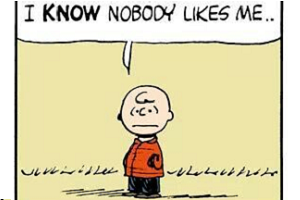You Don’t Really Know Yourself
 Examining the persistence of our negative identity
Examining the persistence of our negative identity
My life’s work has focused on understanding resistance in psychotherapy and more specifically, on people’s fundamental resistance to the formation of a better, more positive image of themselves. For the most part, they are unaware that their lives are controlled and regulated by negative images and attitudes toward themselves that represent a basic aspect of their identity. This provisional identity is made up of three essential parts: (1) the way that they were verbally defined as children; (2) the overall emotional impact of the child’s early environment; and (3) the defenses that they formed to protect themselves from destructive influences.
Parents tend to attribute a fixed identity, whether it be positive or negative, to their offspring. For example, children are defined as the “good one,” the “bad one,” or the “smart one,” etc. They are told that they are stupid, clumsy, stubborn, lazy, defiant and many other negative as well as positive definitions. Unfortunately the negative attributions outweigh the positives in affecting the child’s future.
In addition, children assimilate other more basic, critical attitudes about themselves derived from a less than adequate emotional climate that they experienced growing up, such as feeling that they are dirty, unlovable, unwanted, or a burden. Faced with frustration and emotional pain, they develop defense mechanisms in order to cope. These habitual ways of responding come to be identified by them as part of their core identity as well.
Once the provisional identity is formed, children not only enlarge and elaborate on it, but behave accordingly, thereby constantly reinforcing it. Furthermore, they attack themselves for having the traits. These negative attitudes toward the self continue into adulthood and are represented by inner voices that denigrate and abuse the self. People are largely unconscious of the extent and depth of their self-destructive thoughts and the maladaptive behavior that they predispose. They tend to accept their negative identity as the status quo and rarely think to challenge it. Also, they often defend this outlook to their own detriment and are resistant to changing any aspect of it.
My associates and I have observed a phenomenon that illustrates the persistence of this negative identity even in “normal” individuals. In our work with older children and adolescents, we were impressed by the fact that so many of them held beliefs that they were bad. When asked to make feeling statements such as, “I am good” or “I am lovable,” many exhibited sadness. Even adults who were geographically distant from or independent of their parents were initially reluctant to make positive statements about themselves. It seems that most people can tolerate or even appreciate a certain amount of positive recognition on an intellectual level, but find it difficult to experience it on a feeling level. Why is this so?
A Developmental Perspective
When people make a positive change in their self-image, they tend to become anxious because the change marks a separation from the identity they formed early in life. This separation appears to be related symbolically to breaking the fantasy bond, an imagined connection with their parent or primary caregiver, which arouses feelings of sadness, guilt and anxiety. The fantasy bond is the primary defense against the emotional pain and frustration that all children experience to varying degrees in growing up. The illusion of being merged with the parent offers the infant and young child a sense of safety and security and partly relieves both physical and emotional hunger.
In order to preserve this imagined connection, children must idealize their parents at their own expense. They need to see themselves as bad or unlovable in order to defend against the realization that their parents are inadequate. Recognizing any real faults in the parent would destroy the imagined connection to one’s mother or father and the resultant illusion of self-sufficiency. Many people would say that they do not have a necessarily positive view of their parents or family yet they still have internalized their parents’ destructive attitudes toward them as a basic part of their identity, rather than seeing that their parents were deficient or at fault.
When children block out from conscious awareness their parents’ weaknesses and undesirable traits, they project them onto others in their interpersonal environment. Essentially, people create their own world in that they have a skewed picture of reality and of themselves. They perceive other people and situations through a lens clouded by their need to maintain their negative self-concept.
Moreover, once people project the negative image of their parents onto others, the projections have a negative effect on how others respond to them. This process creates problems in an intimate relationship. Distorted perceptions of a romantic partner are strongly influenced by the destructive thought process or critical inner voice. People expect or anticipate rejection and maintain distance in two principle ways: (1) by maintaining negative thoughts and beliefs about themselves and (2), by maintaining negative projections about their partners. Self-attacks and attacks that demean others both predispose alienation.
Not only do we incorporate a negative image of ourselves within our families, but we also expand and elaborate on this self-image as adults. We mistakenly accept that this definition represents who we really are whereas actually, it is only a label or an identity that was imposed on us as children. Nevertheless, this negative image of self continues to impact our responses to other people throughout our lives.
We tend to provoke the treatment we anticipate, thereby reinforcing our provisional identity. By acting on negative anticipations of rejection and hostility from others, we actually elicit angry reactions and rejection in new relationships. These negative responses, in turn, increase our own hostile or avoidant behavior. A vicious circle is established and our distrustful, victimized thinking, even paranoid ideology, gradually become impervious to change. Often we end up recreating the environment that we grew up in, reliving rather than living our lives.
The negative self-concept is highly resistant to change because by the time they become adults, most people have incorporated a somewhat harsh view of themselves, a well-established, strong fantasy bond with their parents and achieved a psychological equilibrium compatible with their negative views of self. They sense, on a deep unconscious level, that if they changed this familiar, albeit negative, view of themselves, the whole world as they have experienced it would be shattered and they would not know who they were.
Challenging the Negative Self-Concept with Voice Therapy
Voice Therapy enables clients to identify the negative definition of themselves incorporated early in life, to give words to it, and to challenge it by changing behaviors that they unconsciously use to preserve their negative image of self. They expose their self-attacks in a dialogue format.
There are five basic steps involved in helping people separate or differentiate from incorporated voice attacks that help maintain the negative self-concept: (1) revealing their destructive attitudes and feelings toward themselves in the form described above; (2) developing insight regarding the sources of their attacks; (3) answering back by stating their own point of view, that is, describing who they really are from an objective and congenial perspective; (4) recognizing the impact of the voice on present day behavior; and (5) planning and implementing constructive actions that challenge and counter the internalized negative self-concept.
It is understandable that most people have a fear of change, uncertainty, and the unfamiliar. It takes a good deal of courage to live without our customary defenses and the certainty of knowing who we are, even if the definition is negative. However, we have found that people can become accustomed to continual change; in the process, they become more interested in finding themselves rather than defining themselves in narrow or negative terms. It is important here to be aware that there really is no fixed identity as such and that people can change much of how they think and feel, who they are, and how they function.
As people emancipate themselves from imagined connections with parents and challenge negative ways they have defined themselves, they become freer to embrace more effective ways of satisfying their wants and pursuing their priorities and goals. As they give up habitual ways of seeing themselves, largely based on negative projections that their parents made onto them, they will inevitably experience the anxiety aroused by a heightened awareness of their aloneness and vulnerability. Nevertheless, working through these issues is a worthwhile endeavor because it enables a person to live a full and integrated life.
Read more about Voice Therapy in Robert Firestone’s forthcoming book, Overcoming the Destructive Inner Voice: True Stories of Therapy and Transformation.
Tags: critical inner voice, critical self-image, fantasy bond, inner critic, negative self-image, psychological advice, real-self, self development, self-image, voice therapy








Leave a Reply